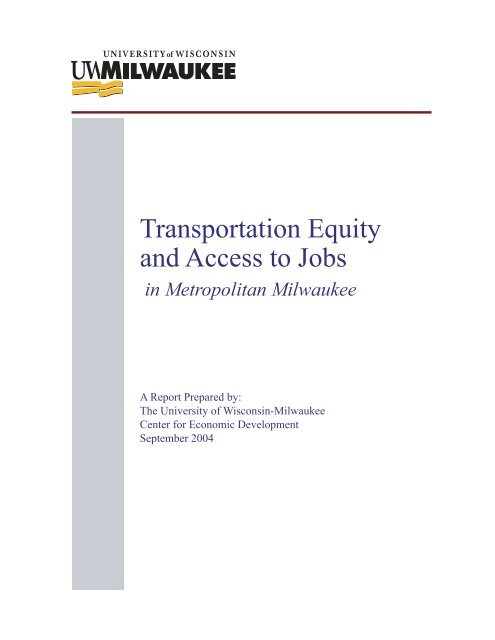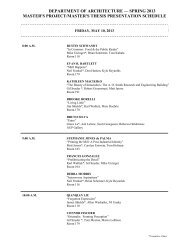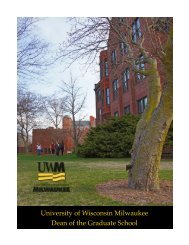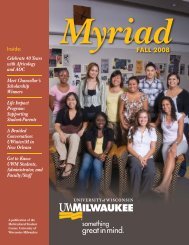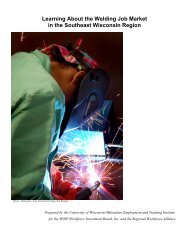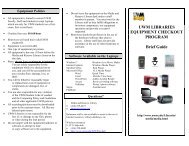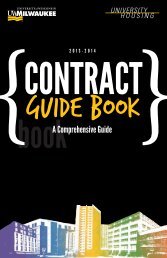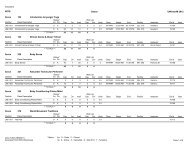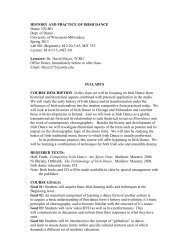Transportation Equity and Access to Jobs in ... - UW-Milwaukee
Transportation Equity and Access to Jobs in ... - UW-Milwaukee
Transportation Equity and Access to Jobs in ... - UW-Milwaukee
Create successful ePaper yourself
Turn your PDF publications into a flip-book with our unique Google optimized e-Paper software.
<strong>Transportation</strong> <strong>Equity</strong><strong>and</strong> <strong>Access</strong> <strong>to</strong> <strong>Jobs</strong><strong>in</strong> Metropolitan <strong>Milwaukee</strong>A Report Prepared by:The University of Wiscons<strong>in</strong>-<strong>Milwaukee</strong>Center for Economic DevelopmentSeptember 2004
2About This ReportThis report was produced at the University of Wiscons<strong>in</strong>-<strong>Milwaukee</strong> Center for EconomicDevelopment (<strong>UW</strong>MCED), a unit of the College of Letters <strong>and</strong> Science at the University ofWiscons<strong>in</strong>-<strong>Milwaukee</strong>. The College established <strong>UW</strong>MCED <strong>in</strong> 1990, with the assistance of agrant from the U.S. Department of Commerce, Economic Development Adm<strong>in</strong>istration’s“University Center” program, <strong>to</strong> provide university research <strong>and</strong> technical assistance <strong>to</strong>community organizations <strong>and</strong> units of government work<strong>in</strong>g <strong>to</strong> improve the Greater <strong>Milwaukee</strong>economy. In 2000, <strong>UW</strong>MCED also became part of <strong>UW</strong>M’s “<strong>Milwaukee</strong> Idea,” as one of thecore units of the “Consortium for Economic Opportunity.” The analysis <strong>and</strong> conclusionspresented <strong>in</strong> this report are solely those of <strong>UW</strong>MCED <strong>and</strong> do not necessarily reflect the views<strong>and</strong> op<strong>in</strong>ions of <strong>UW</strong>-<strong>Milwaukee</strong> or the U.S. Department of Commerce.The author of this report is Joel Rast, assistant professor of Political Science <strong>and</strong> Urban Studies.Chieko Maene, a research assistant at the Center, provided <strong>in</strong>dispensable assistance.<strong>UW</strong>MCED strongly believes that <strong>in</strong>formed public debate is vital <strong>to</strong> the development of goodpublic policy. The Center publishes brief<strong>in</strong>g papers, detailed analyses of economic trends <strong>and</strong>policies, <strong>and</strong> “technical assistance” reports on issues of applied economic development. In theseways, as well as <strong>in</strong> conferences <strong>and</strong> public lectures sponsored by the Center, we hope <strong>to</strong>contribute <strong>to</strong> public discussion of economic development policy <strong>in</strong> Southeastern Wiscons<strong>in</strong>.Further <strong>in</strong>formation about the Center <strong>and</strong> its reports <strong>and</strong> activities is availableat our web site: www.ced.uwm.edu
3Executive SummaryThis study exam<strong>in</strong>es how well public transit <strong>in</strong> <strong>Milwaukee</strong>, Ozaukee, Waukesha, <strong>and</strong>Wash<strong>in</strong>g<strong>to</strong>n counties provides low-<strong>in</strong>come residents of the 4-county region with access <strong>to</strong> jobopportunities. Researchers have long observed a “spatial mismatch” between job growth centers<strong>and</strong> low-<strong>in</strong>come residential communities <strong>in</strong> metropolitan areas around the country. Studies showthat for decades, the suburban share of metropolitan jobs has been steadily <strong>in</strong>creas<strong>in</strong>g, while low<strong>in</strong>comepopulations typically rema<strong>in</strong> concentrated <strong>in</strong> central city neighborhoods far removedfrom regional job growth centers. Because low-<strong>in</strong>come persons frequently do not have access <strong>to</strong>an au<strong>to</strong>mobile, effective public transportation is often crucial <strong>in</strong> bridg<strong>in</strong>g the gap between the<strong>in</strong>ner-city locations of low-<strong>in</strong>come populations <strong>and</strong> the <strong>in</strong>creas<strong>in</strong>gly suburban locations of jobopportunities.Our research confirms the presence of a spatial mismatch between low-<strong>in</strong>come residentialcommunities <strong>and</strong> job opportunities <strong>in</strong> the <strong>Milwaukee</strong> region. Eighty-one percent of familiesliv<strong>in</strong>g below the poverty l<strong>in</strong>e are located <strong>in</strong> the city of <strong>Milwaukee</strong>. By contrast, only 30 percen<strong>to</strong>f bus<strong>in</strong>esses with strong hir<strong>in</strong>g projections for entry-level workers are located <strong>in</strong> <strong>Milwaukee</strong>.The rema<strong>in</strong><strong>in</strong>g 70 percent are <strong>in</strong> the suburbs.Families <strong>in</strong> the <strong>Milwaukee</strong> region liv<strong>in</strong>g below the poverty level rely heavily on publictransportation. Accord<strong>in</strong>g <strong>to</strong> 2000 US Census data, 36.6 percent of <strong>Milwaukee</strong>-area families with<strong>in</strong>comes below the poverty level have no access <strong>to</strong> a vehicle, while only 4.4 percent of familiesabove the poverty level have no access <strong>to</strong> a vehicle. Public transit is only partially effective <strong>in</strong>connect<strong>in</strong>g <strong>in</strong>ner-city residents with job opportunities <strong>in</strong> the region. Most low-<strong>in</strong>come familiesare located with<strong>in</strong> walk<strong>in</strong>g distance of bus s<strong>to</strong>ps. However, many potential job opportunities are<strong>in</strong>accessible by transit. Our analysis shows that:• 59.1 percent of bus<strong>in</strong>esses with strong hir<strong>in</strong>g projections for entry-level workers are locatedwith<strong>in</strong> ¼ mile of bus l<strong>in</strong>es.• 63.5 percent of bus<strong>in</strong>esses with strong hir<strong>in</strong>g projections for entry-level workers are locatedwith<strong>in</strong> ½ mile of bus l<strong>in</strong>es.
4When travel times are fac<strong>to</strong>red <strong>in</strong><strong>to</strong> the analysis, the percentage of bus<strong>in</strong>esses accessible by low<strong>in</strong>comeresidents decl<strong>in</strong>es significantly. For example, for residents of the Wash<strong>in</strong>g<strong>to</strong>nPark/Walnut Hill neighborhood on <strong>Milwaukee</strong>’s west side, only 40.4 percent of bus<strong>in</strong>esses withstrong hir<strong>in</strong>g projections for entry-level workers are located with<strong>in</strong> ¼ mile of bus l<strong>in</strong>es <strong>and</strong>reachable with<strong>in</strong> a one-hour commute. For residents of the Near South Side, the number falls <strong>to</strong>32.4 percent.Our f<strong>in</strong>d<strong>in</strong>gs take on added significance when recent developments <strong>in</strong> regional transportationoperations <strong>and</strong> plann<strong>in</strong>g are taken <strong>in</strong><strong>to</strong> account. In 2003, the Southeastern Wiscons<strong>in</strong> RegionalPlann<strong>in</strong>g Commission (SEWRPC) revised its long-range regional transportation plan <strong>to</strong> <strong>in</strong>clude aproposed $6.23 billion reconstruction of the entire 270-mile Southeastern Wiscons<strong>in</strong> highwaysystem. If implemented, the plan will consume a substantial share of the region’s federal <strong>and</strong>state transportation dollars dur<strong>in</strong>g the next 30 years. Meanwhile, <strong>Milwaukee</strong> County TransitServices (MCTS), the pr<strong>in</strong>cipal transit provider <strong>in</strong> the region, has reduced bus service every years<strong>in</strong>ce 2001. The present climate <strong>in</strong> Southeastern Wiscons<strong>in</strong> is thus one of retrenchment for publictransit <strong>and</strong> expansion for highways.Choices presently be<strong>in</strong>g made about the future of transportation <strong>in</strong> Southeastern Wiscons<strong>in</strong> willshape the region’s transportation <strong>in</strong>frastructure for years <strong>to</strong> come. If we cont<strong>in</strong>ue along thepresent trajec<strong>to</strong>ry—massive public <strong>in</strong>vestments <strong>in</strong> highway reconstruction <strong>and</strong> reduced fund<strong>in</strong>gfor public transit—the outcome is clear. Ultimately, we will f<strong>in</strong>d ourselves with twotransportation systems, separate <strong>and</strong> unequal—one, a state-of-the-art highway network whosepr<strong>in</strong>cipal beneficiaries are white, middle-class suburban residents; the other, an underfundedpublic transit system serv<strong>in</strong>g as the transportation of last resort for the region’s least privilegedresidents. It will take significantly greater vision <strong>and</strong> foresight than policymakers have recentlyshown <strong>to</strong> reverse the course we are presently on. Should we fail <strong>to</strong> do so, the price will be aregion <strong>in</strong>creas<strong>in</strong>gly divided by race <strong>and</strong> class.
5IntroductionThis study exam<strong>in</strong>es how well public transit <strong>in</strong> <strong>Milwaukee</strong>, Ozaukee, Waukesha, <strong>and</strong>Wash<strong>in</strong>g<strong>to</strong>n counties provides low-<strong>in</strong>come residents of the 4-county region with access <strong>to</strong> jobopportunities. Researchers have long observed a “spatial mismatch” between job growth centers<strong>and</strong> low-<strong>in</strong>come residential communities <strong>in</strong> metropolitan areas around the country. Studies showthat for decades, the suburban share of metropolitan jobs has been steadily <strong>in</strong>creas<strong>in</strong>g, while low<strong>in</strong>comepopulations typically rema<strong>in</strong> concentrated <strong>in</strong> central city neighborhoods far removedfrom regional job growth centers. Because low-<strong>in</strong>come persons frequently do not have access <strong>to</strong>an au<strong>to</strong>mobile, effective public transportation is often crucial <strong>in</strong> bridg<strong>in</strong>g the gap between the<strong>in</strong>ner-city locations of low-<strong>in</strong>come populations <strong>and</strong> the <strong>in</strong>creas<strong>in</strong>gly suburban locations of jobopportunities.In recent years, a number of developments have given the issue of job access by low-<strong>in</strong>comepopulations renewed salience. In 1996, President Cl<strong>in</strong><strong>to</strong>n signed the Personal Responsibility <strong>and</strong>Work Opportunity Reconciliation Act, which replaced Aid <strong>to</strong> Families with Dependent Children(AFDC) with Temporary Assistance for Needy Families (TANF). Under TANF, the federalgovernment no longer provides cash assistance directly <strong>to</strong> welfare recipients. Instead, statesreceive block grants <strong>to</strong> establish <strong>and</strong> adm<strong>in</strong>ister their own family assistance programs with<strong>in</strong>federal guidel<strong>in</strong>es. Wiscons<strong>in</strong>’s TANF program, Wiscons<strong>in</strong> Works (W-2), was established <strong>in</strong>1997.A key objective of both TANF <strong>and</strong> Wiscons<strong>in</strong>’s W-2 program is work participation. Federal lawrequires that a certa<strong>in</strong> percentage of each state’s TANF recipients participate <strong>in</strong> work relatedactivities for a m<strong>in</strong>imum number of hours per week. In addition, both TANF <strong>and</strong> W-2 conta<strong>in</strong> afive year limit on assistance. Families cannot receive assistance for more than five years unlessthey qualify for a special hardship exemption. Work participation requirements <strong>and</strong> time limitson the receipt of benefits make access <strong>to</strong> job opportunities a crucial aspect of welfare reform. Asformer US Secretary of <strong>Transportation</strong> Rodney Slater once put it, “<strong>Transportation</strong> is the ‘<strong>to</strong>’ <strong>in</strong>Welfare-<strong>to</strong>-Work.”
6The issues of spatial mismatch <strong>and</strong> job access for low-<strong>in</strong>come residents are also important <strong>in</strong> thecurrent debate over the future of transportation <strong>in</strong> Southeastern Wiscons<strong>in</strong>. In 2003, theSoutheastern Wiscons<strong>in</strong> Regional Plann<strong>in</strong>g Commission (SEWRPC) revised its long-rangeregional transportation plan <strong>to</strong> <strong>in</strong>clude a proposed $6.23 billion reconstruction of the entire 270-mile Southeastern Wiscons<strong>in</strong> highway system. In addition <strong>to</strong> rebuild<strong>in</strong>g the exist<strong>in</strong>g highwaysystem, the plan recommends the construction of additional freeway lanes on 127 miles of thesystem. If implemented, the plan will consume a substantial share of the region’s federal <strong>and</strong>state transportation dollars dur<strong>in</strong>g the next 30 years. Meanwhile, fund<strong>in</strong>g for public transitcont<strong>in</strong>ues <strong>to</strong> decrease. <strong>Milwaukee</strong> County Transit Services (MCTS), the pr<strong>in</strong>cipal transitprovider <strong>in</strong> the region, has reduced bus service every year s<strong>in</strong>ce 2001. Together with a bus fare<strong>in</strong>crease approved <strong>in</strong> 2003 <strong>to</strong> help address the revenue shortfall, service reductions are expected<strong>to</strong> reduce ridership <strong>to</strong> the lowest levels s<strong>in</strong>ce 1976 (S<strong>and</strong>ler & Umhoefer, 2003). The presentclimate <strong>in</strong> Southeastern Wiscons<strong>in</strong> is thus one of retrenchment for public transit <strong>and</strong> expansionfor highways.This study seeks <strong>to</strong> address two pr<strong>in</strong>cipal questions:• Is there a spatial mismatch between low-<strong>in</strong>come residential neighborhoods <strong>and</strong> locations ofjob opportunities <strong>in</strong> the 4-county <strong>Milwaukee</strong> region?• How well does public transportation provide low-<strong>in</strong>come residents with access <strong>to</strong> jobopportunities <strong>in</strong> the 4-county region?We beg<strong>in</strong> by exam<strong>in</strong><strong>in</strong>g the degree <strong>to</strong> which low-<strong>in</strong>come populations <strong>in</strong> the <strong>Milwaukee</strong> regionrely on public transportation for access <strong>to</strong> job opportunities. We then identify the locations ofentry-level jobs <strong>in</strong> the region with strong hir<strong>in</strong>g projections. Next we determ<strong>in</strong>e how effectivelypublic transportation provides low-<strong>in</strong>come residents with access <strong>to</strong> these job sites. F<strong>in</strong>ally, weconsider the implications of recent transportation-related developments—<strong>in</strong>clud<strong>in</strong>g SEWRPC’shighway reconstruction plans <strong>and</strong> MCTS’s service reductions—for transit-dependent workers<strong>and</strong> job seekers.Spatial Mismatch <strong>and</strong> <strong>Access</strong> <strong>to</strong> EmploymentThe spatial mismatch thesis was first advanced by Harvard economist John Ka<strong>in</strong> <strong>in</strong> a 1968 article<strong>in</strong> the Quarterly Journal of Economics (Ka<strong>in</strong>, 1968). Ka<strong>in</strong> exam<strong>in</strong>ed the residential locations of
7African Americans <strong>in</strong> Detroit <strong>and</strong> Chicago <strong>and</strong> trends <strong>in</strong> the location of employmen<strong>to</strong>pportunities <strong>in</strong> both regions. He found that bus<strong>in</strong>esses were decentraliz<strong>in</strong>g at a rapid pace <strong>and</strong>that hous<strong>in</strong>g discrim<strong>in</strong>ation prevented African Americans from follow<strong>in</strong>g jobs <strong>to</strong> the suburbs.Moreover, suburban job growth centers were largely <strong>in</strong>accessible <strong>to</strong> <strong>in</strong>ner-city residents viapublic transit. Ka<strong>in</strong> concluded that high unemployment rates of <strong>in</strong>ner-city African Americanswere partially attributable <strong>to</strong> job decentralization <strong>and</strong> the failure of public transit <strong>to</strong> connect<strong>in</strong>ner-city residents with suburban job locations.Ka<strong>in</strong>’s f<strong>in</strong>d<strong>in</strong>gs led <strong>to</strong> a volum<strong>in</strong>ous body of literature on the issue of spatial mismatch whichlargely supports his thesis (Ihlanfeldt & Sjoquist, 1998; Holzer, 1991; Ihlanfeldt, 1992; Moss &Tilly, 1991; Wheeler, 1990). If anyth<strong>in</strong>g, the literature suggests that the patterns Ka<strong>in</strong> observeddur<strong>in</strong>g the 1960s have become more pronounced over time, as low-<strong>in</strong>come <strong>and</strong> m<strong>in</strong>oritypopulations rema<strong>in</strong> largely concentrated <strong>in</strong> central city locations, while bus<strong>in</strong>esses cont<strong>in</strong>ue <strong>to</strong>decentralize at a rapid pace (Jargowski, 1997). John Kasarda (1995) estimates that metropolitanemployment has been shift<strong>in</strong>g <strong>to</strong> the suburbs at a rate of roughly 1 percent per year s<strong>in</strong>ce the1970s.Recent developments have sparked renewed <strong>in</strong>terest <strong>in</strong> the spatial mismatch question. First, thewelfare reform <strong>in</strong>itiatives of the 1990s have made the issue of access <strong>to</strong> jobs an <strong>in</strong>creas<strong>in</strong>glycentral public policy question <strong>in</strong> states <strong>and</strong> metropolitan regions around the country. TANF’swork participation requirements <strong>and</strong> 5-year limit on the receipt of benefits have encouragedpublic officials <strong>to</strong> reexam<strong>in</strong>e transportation l<strong>in</strong>ks between welfare recipients <strong>and</strong> potential joblocations. Some regional plann<strong>in</strong>g agencies have produced studies <strong>to</strong> identify potential spatialmismatch problems <strong>and</strong> provide recommendations <strong>to</strong> address the issue (Delaware ValleyRegional Plann<strong>in</strong>g Commission, 1998, 1999; New Jersey <strong>Transportation</strong> Plann<strong>in</strong>g Authority,1999; San Luis Obispo Council of Governments, 1998).In addition, new federal environmental justice laws require Metropolitan Plann<strong>in</strong>g Organizations(MPOs) <strong>to</strong> exam<strong>in</strong>e equity concerns <strong>in</strong> the preparation of regional transportation plans. Inaccordance with President Cl<strong>in</strong><strong>to</strong>n’s 1994 executive order on environmental justice, the FederalHighway Adm<strong>in</strong>istration now requires MPOs <strong>to</strong> demonstrate that regional transportation plansspecifically address the transportation needs of low-<strong>in</strong>come <strong>and</strong> m<strong>in</strong>ority populations. To comply
8with federal requirements on environmental justice, MPOs have conducted studies <strong>to</strong> determ<strong>in</strong>ewhether regional public transportation systems are effective <strong>in</strong> provid<strong>in</strong>g access <strong>to</strong> job growthcenters by low-<strong>in</strong>come <strong>and</strong> m<strong>in</strong>ority residents (Federal Highway Adm<strong>in</strong>istration, 2000).F<strong>in</strong>ally, recent studies exam<strong>in</strong><strong>in</strong>g access <strong>to</strong> jobs have benefited from the <strong>in</strong>troduction ofGeographic Information Systems (GIS) technology, which enables researchers <strong>to</strong> spatiallyrepresent transit l<strong>in</strong>es, low-<strong>in</strong>come residential areas, <strong>and</strong> job locations. GIS has vastly improvedthe analytical capabilities of spatial mismatch research. For example, GIS allows researchers <strong>to</strong>determ<strong>in</strong>e the percentage of low-<strong>in</strong>come households <strong>in</strong> a region located with<strong>in</strong> walk<strong>in</strong>g distanceof public transit, or the percentage of job opportunities located with<strong>in</strong> walk<strong>in</strong>g distance of publictransit.Low-Income Populations <strong>and</strong> Public <strong>Transportation</strong>The US Census Bureau currently def<strong>in</strong>es poverty as an <strong>in</strong>come of $16,895 or less for a family offour. By this def<strong>in</strong>ition, there are a <strong>to</strong>tal of 29,386 families liv<strong>in</strong>g <strong>in</strong> poverty <strong>in</strong> the 4-county<strong>Milwaukee</strong> region, accord<strong>in</strong>g <strong>to</strong> 2000 US Census figures. Map 1 shows the locations of thesefamilies. The vast majority of them are located <strong>in</strong> either the city of <strong>Milwaukee</strong> (81 percent) or <strong>in</strong><strong>Milwaukee</strong> County (90 percent).To what extent do these families rely on public transportation? Map 2 shows the percentage ofhouseholds with no vehicle available for each census block group <strong>in</strong> the 4-county region. In theareas shaded <strong>in</strong> red, between 45 <strong>and</strong> 100 percent of households have no vehicle available. Bycontrast, <strong>in</strong> the areas <strong>in</strong> white, 10 percent or fewer households have no vehicle available. As Map2 <strong>in</strong>dicates, households with no vehicles available are far more likely <strong>to</strong> be located <strong>in</strong> the city of<strong>Milwaukee</strong> <strong>and</strong> <strong>Milwaukee</strong> County than elsewhere <strong>in</strong> the 4-county region.Although it is <strong>in</strong>terest<strong>in</strong>g <strong>to</strong> observe that households <strong>in</strong> <strong>Milwaukee</strong> County are less likely <strong>to</strong> haveaccess <strong>to</strong> a car than households elsewhere <strong>in</strong> the region, we wanted <strong>to</strong> know more specificallyhow closely vehicle ownership is correlated with household <strong>in</strong>come. We used descriptivestatistics (Pearson’s r) <strong>to</strong> test this correlation. Figure 1 shows the relationship between twovariables: the percentage of households with no vehicle available <strong>and</strong> the percentage of families
9liv<strong>in</strong>g below the poverty level <strong>in</strong> the 4-county region. Each po<strong>in</strong>t <strong>in</strong> Figure 1 represents onecensus block group. The Pearson’s r coefficients <strong>in</strong>dicate that there is a strong l<strong>in</strong>ear relationshipbetween the two variables. The higher the percentage of families below the poverty level <strong>in</strong> agiven block group, the higher the percentage of households with no vehicle available.
11Figure 1. Au<strong>to</strong> Ownership <strong>and</strong> Families Below the Poverty Level, <strong>Milwaukee</strong> Metro Area10080Percent of HH with no vehicle available6040200020406080100Percent of families below poverty levelCoefficients: between % of households with no vehicle available & % of families <strong>in</strong> povertyModelUnst<strong>and</strong>ardized CoefficientsSt<strong>and</strong>ardizedCoefficients t Sig.B Std. Error Beta1 (Constant) 5.278 .310 17.034 .000Families <strong>in</strong> poverty .799 .017 .789 45.778 .000Dependent variable: Percentage of households with no vehicle availableAs an additional measure of vehicle ownership, we exam<strong>in</strong>ed US Census PUMS data for the 4-county region. Accord<strong>in</strong>g <strong>to</strong> the data, 36.6 percent of families below the poverty level have noaccess <strong>to</strong> a vehicle, while only 4.4 percent of families above the poverty level have no access <strong>to</strong> avehicle. The results are slightly different when households <strong>in</strong>stead of families are used as the uni<strong>to</strong>f analysis. For households below the poverty l<strong>in</strong>e, 42.1 percent have no access <strong>to</strong> a vehicle; forhouseholds above the poverty l<strong>in</strong>e, the number falls <strong>to</strong> 8.8 percent.
12F<strong>in</strong>ally, US Census data on the racial <strong>and</strong> <strong>in</strong>come characteristics of bus riders <strong>in</strong> the <strong>Milwaukee</strong>Metropolitan area <strong>in</strong>dicate that a large percentage of bus riders are low-<strong>in</strong>come <strong>and</strong> m<strong>in</strong>orityresidents. Figure 2 shows the <strong>in</strong>come profile for commuters <strong>in</strong> the 4-county region. Twenty-sixpercent of bus commuters <strong>in</strong> the region have household <strong>in</strong>comes below $20,000, as comparedwith 7.3 percent of all commuters. Figure 3 shows the racial <strong>and</strong> ethnic profile of bus commuters<strong>in</strong> the 4-county region. In the city of <strong>Milwaukee</strong>, the vast majority of bus commuters (67.2percent) are m<strong>in</strong>orities, with African Americans represent<strong>in</strong>g the largest share (49.4 percent)followed by Lat<strong>in</strong>os (13.8 percent) <strong>and</strong> Asians (1.7 percent).Figure 2. Income Profiles, Metro <strong>Milwaukee</strong> Commuters60.0%50.0%Bus CommutersAll Commuters53.3%40.0%32.1%30.0%20.0%25.5%17.1%22.3%20.5%21.9%10.0%7.3%0.0%Under $20K $20K-40K $40K-60K $60K or +Source: US Census, 2000, PUMS
13Figure 3. Racial <strong>and</strong> Ethnic Profiles, Metro <strong>Milwaukee</strong> Bus Commuters100.0%97.1%80.0%NH whiteNH BlackNH AsianHispanic84.7%60.0%49.4%40.0%32.8%20.0%0.0%13.8%6.1%3.9%1.7%3.7%2.0%0.0% 0.0%<strong>Milwaukee</strong> City Rem<strong>in</strong>der of Milw Co. WOW CountiesSource: US Census, 2000, PUMSThe data on vehicle ownership <strong>and</strong> transit use <strong>in</strong> the 4-county region suggest that effective publictransportation is crucial <strong>in</strong> meet<strong>in</strong>g the transportation needs of both low-<strong>in</strong>come <strong>and</strong> m<strong>in</strong>oritypopulations. Low vehicle ownership rates for households liv<strong>in</strong>g <strong>in</strong> poverty mean that publictransportation is likely <strong>to</strong> play a decisive role <strong>in</strong> efforts <strong>to</strong> connect low-<strong>in</strong>come residents with jobopportunities <strong>in</strong> the region.Entry-Level Job LocationsAs <strong>in</strong> most metropolitan areas around the country, job growth <strong>in</strong> the <strong>Milwaukee</strong> region <strong>in</strong> recentdecades has been concentrated <strong>in</strong> the suburbs. Table 1 shows changes <strong>in</strong> employment for the 4-county region from 1970-2000. In 1970, 57 percent of the 4-county region’s jobs were located <strong>in</strong>the city of <strong>Milwaukee</strong>. By 2000, that figure had dropped <strong>to</strong> 38 percent.
14Table 1. Job Decentralization <strong>in</strong> the <strong>Milwaukee</strong> Region1970 1980 1990 2000 % Change,1970-2000<strong>Milwaukee</strong> 293,800 306,697 314,960 285,260 -2.9(city)<strong>Milwaukee</strong> 420,000 456,126 483,594 463,914 10.5CountyOzaukee 16,400 22,037 30,172 39,126 138.6CountyWaukesha 62,700 105,833 160,711 209,068 178.6CountyWash<strong>in</strong>g<strong>to</strong>n 17,400 26,773 36,574 48,482 233.4CountyMetro Total 516,500 610,769 711,021 760,590 47.3Source: US Census (1970, 1980, 1990, 2000). Journey <strong>to</strong> Work.Although it is clear that employment has decentralized, our objective is <strong>to</strong> determ<strong>in</strong>e morespecifically how decentralization has affected access <strong>to</strong> job opportunities for low-<strong>in</strong>comeresidents. To do so, it is first necessary <strong>to</strong> determ<strong>in</strong>e how employment opportunities for low<strong>in</strong>comepersons will be measured. Studies have done this <strong>in</strong> different ways. Some studies simply<strong>in</strong>clude all job locations <strong>in</strong> the region (San Luis Obispo Council of Governments, 1998). This,however, clearly overstates prospective job opportunities for low-<strong>in</strong>come persons s<strong>in</strong>ce it<strong>in</strong>cludes many positions for which such persons are unlikely <strong>to</strong> be qualified. Other studies haves<strong>in</strong>gled out the largest employers <strong>in</strong> the region (North Central Florida Regional Plann<strong>in</strong>gCouncil, 1999). This is also problematic because the largest employers may not be the ones mostlikely <strong>to</strong> hire low-<strong>in</strong>come persons. Some studies focus specifically on entry-level positions(Lacombe, 1998; Thakuriah et al., 1999). This seems appropriate s<strong>in</strong>ce most low-<strong>in</strong>come jobseekers are likely <strong>to</strong> be look<strong>in</strong>g for entry-level jobs.Our study uses employment projections from the Wiscons<strong>in</strong> Department of WorkforceDevelopment report, Wiscons<strong>in</strong> Projections, 1998-2008. The report identifies occupations withthe largest number of projected annual open<strong>in</strong>gs requir<strong>in</strong>g short-term, on-the-job tra<strong>in</strong><strong>in</strong>g <strong>in</strong> the4-county <strong>Milwaukee</strong> region. This data source is particularly useful because it <strong>in</strong>cludes thoseentry-level positions for which hir<strong>in</strong>g is likely <strong>to</strong> be greatest. We selected the 10 occupationsprojected <strong>to</strong> produce the highest number of new job open<strong>in</strong>gs dur<strong>in</strong>g the 1998-2008 period. The
15Department of Workforce Development projects that these 10 occupations will yield an averageof 6,568 job open<strong>in</strong>gs per year from 1998-2008. Table 2 lists these occupations <strong>and</strong> employmentprojections.Table 2. Occupations with the Largest Number of Annual Open<strong>in</strong>gs Requir<strong>in</strong>g Short-Term, On-The-Job Tra<strong>in</strong><strong>in</strong>g, 1998-2008.OccupationProjected Annual Open<strong>in</strong>gs, % of Total Annual1998-2008 (4-County Region) Open<strong>in</strong>gsRetail Salespersons 1,068 16.3Cashiers 1,000 15.2Office Clerks, General 870 13.2Waiters & Waitresses 816 12.4Food Prep/Service 545 8.3Workers, Fast FoodFood Preparation 500 7.6WorkersHelpers/Laborers/Movers, 488 7.4NECJani<strong>to</strong>rs & Cleaners 455 6.9Assemblers &415 6.3Fabrica<strong>to</strong>rs, NECH<strong>and</strong> Packers & 411 6.3PackagersTotal 6,568 100Source: Wiscons<strong>in</strong> Department of Workforce Development, Wiscons<strong>in</strong> Projections, 1998-2008.To determ<strong>in</strong>e the employers most likely <strong>to</strong> hire workers <strong>in</strong> these occupations, we converted theoccupations <strong>to</strong> bus<strong>in</strong>esses us<strong>in</strong>g the US Department of Labor’s <strong>in</strong>dustry-occupation matrix. Wethen identified the locations of these bus<strong>in</strong>esses us<strong>in</strong>g SNAP data from the Wiscons<strong>in</strong>Department of Workforce Development. The SNAP database conta<strong>in</strong>s the addresses of allWiscons<strong>in</strong> employers covered under the state’s unemployment <strong>in</strong>surance laws. Us<strong>in</strong>g thismethod, we identified a <strong>to</strong>tal of 13,987 prospective employers of low-<strong>in</strong>come residents <strong>in</strong> the4-county region. Map 3 shows the locations of these bus<strong>in</strong>esses. Many of them are located
16outside of the city of <strong>Milwaukee</strong>. As Table 3 shows, 4,190 employers (30 percent of <strong>to</strong>tal) arelocated with<strong>in</strong> the city of <strong>Milwaukee</strong>, while 9,797 employers (70 percent of <strong>to</strong>tal) are locatedelsewhere <strong>in</strong> the 4-county region.
17Table 3. Bus<strong>in</strong>esses with Strong Hir<strong>in</strong>g Projections for Entry-Level WorkersNumber ofBus<strong>in</strong>essesPercent ofTotal<strong>Milwaukee</strong>(city)<strong>Milwaukee</strong>County(non-city)OzaukeeCountyWaukeshaCountyWash<strong>in</strong>g<strong>to</strong>nCountyTotal4,190 3,582 903 4,143 1,169 13,98730 25.6 6.5 29.6 8.4 100Regional Transit ServicesGiven that many low-<strong>in</strong>come residents have no access <strong>to</strong> an au<strong>to</strong>mobile <strong>and</strong> that the majority ofthe region’s entry-level jobs are located <strong>in</strong> the suburbs, public transit is clearly important <strong>in</strong>provid<strong>in</strong>g low-<strong>in</strong>come residents with access <strong>to</strong> employment. What sorts of public transit optionsare available <strong>to</strong> low-<strong>in</strong>come workers <strong>and</strong> job seekers <strong>in</strong> the <strong>Milwaukee</strong> region?There are two pr<strong>in</strong>cipal public transit providers <strong>in</strong> the region: <strong>Milwaukee</strong> County Transit System(MCTS) <strong>and</strong> Waukesha Metro Transit. MCTS operates bus service with<strong>in</strong> <strong>Milwaukee</strong> County. Italso operates the Ozaukee County Express, which provides limited service (one bus route)between the cities of <strong>Milwaukee</strong> <strong>and</strong> Port Wash<strong>in</strong>g<strong>to</strong>n. Waukesha Metro Transit services the cityof Waukesha <strong>and</strong> several neighbor<strong>in</strong>g communities <strong>to</strong> the east along Bluemound Road betweenWaukesha <strong>and</strong> Brookfield Square. MCTS Route 10 provides a l<strong>in</strong>k between the MCTS <strong>and</strong>Waukesha Metro Transit systems, enabl<strong>in</strong>g commuters <strong>in</strong> <strong>Milwaukee</strong> <strong>to</strong> reach dest<strong>in</strong>ations <strong>in</strong> thecity of Waukesha. The other transit provider <strong>in</strong> the region is the Wash<strong>in</strong>g<strong>to</strong>n County CommuterExpress, which provides limited service between Wash<strong>in</strong>g<strong>to</strong>n County <strong>and</strong> the city of <strong>Milwaukee</strong>.We chose <strong>to</strong> exclude Wash<strong>in</strong>g<strong>to</strong>n County Commuter Express from the study because itsschedul<strong>in</strong>g makes reverse commut<strong>in</strong>g impractical. Bus service from <strong>Milwaukee</strong> <strong>to</strong> Wash<strong>in</strong>g<strong>to</strong>nCounty does not beg<strong>in</strong> until 3:15 p.m.Map 4 shows the exist<strong>in</strong>g public transit system for the 4-county <strong>Milwaukee</strong> region. As Map 4<strong>in</strong>dicates, transit service is concentrated <strong>in</strong> <strong>Milwaukee</strong> County <strong>and</strong> the city of Waukesha. Largeportions of the region—<strong>in</strong>clud<strong>in</strong>g all of Wash<strong>in</strong>g<strong>to</strong>n County, most of Ozaukee County, <strong>and</strong> largeportions of Waukesha County—cannot be reached by transit-dependent workers or job seekersliv<strong>in</strong>g <strong>in</strong> <strong>Milwaukee</strong> County.
18<strong>Access</strong> <strong>to</strong> <strong>Jobs</strong> by Low-Income ResidentsHow effectively does public transit meet the commut<strong>in</strong>g needs of low-<strong>in</strong>come workers <strong>and</strong> jobseekers <strong>in</strong> the <strong>Milwaukee</strong> region? To answer this question, our first step was <strong>to</strong> determ<strong>in</strong>e thedegree <strong>to</strong> which low-<strong>in</strong>come residents have access <strong>to</strong> transit. Map 5 shows the location of highpovertycensus block groups <strong>and</strong> bus routes <strong>in</strong> the 4-county region. 1 Because our geographic datafor families with <strong>in</strong>comes below the poverty l<strong>in</strong>e consists of census block groups rather thanpersonal addresses, we were unable <strong>to</strong> determ<strong>in</strong>e access <strong>to</strong> transit with great precision. However,our analysis does suggest that most low-<strong>in</strong>come families <strong>in</strong> the region have good access <strong>to</strong>transit. All high-poverty census block groups are located with<strong>in</strong> ¼ mile of a bus route.1 High poverty census block groups were def<strong>in</strong>ed as block groups <strong>in</strong> which 20 percent or more families had <strong>in</strong>comesbelow the poverty threshold.
20Our next step was <strong>to</strong> determ<strong>in</strong>e which bus<strong>in</strong>esses <strong>in</strong> the region represent<strong>in</strong>g the most likelyemployers of low-<strong>in</strong>come residents are accessible by public transit. Map 6 shows regional busroutes <strong>and</strong> the locations of bus<strong>in</strong>esses with strong hir<strong>in</strong>g projections for entry-level workers. It isclear from Map 6 that many of these bus<strong>in</strong>esses cannot be reached by public transit. Us<strong>in</strong>g GISanalysis, it is possible <strong>to</strong> determ<strong>in</strong>e more precisely what percentage of these bus<strong>in</strong>esses arelocated with<strong>in</strong> walk<strong>in</strong>g distance of bus routes. Our analysis shows that:• 59.1 percent of bus<strong>in</strong>esses with strong hir<strong>in</strong>g projections for entry-level workers are locatedwith<strong>in</strong> ¼ mile of bus l<strong>in</strong>es.• 63.5 percent of bus<strong>in</strong>esses with strong hir<strong>in</strong>g projections for entry-level workers are locatedwith<strong>in</strong> ½ mile of bus l<strong>in</strong>es.These figures represent a first cut at determ<strong>in</strong><strong>in</strong>g how well public transportation provides low<strong>in</strong>comeresidents with access <strong>to</strong> job opportunities. However, these numbers clearly overstate thepercentage of prospective employers of low-<strong>in</strong>come residents accessible by public transit. This isthe case because our analysis thus far does not <strong>in</strong>corporate commute times. Bus travel can betime consum<strong>in</strong>g. Inner-city residents travel<strong>in</strong>g <strong>to</strong> employment sites <strong>in</strong> distant portions of theregion may be required <strong>to</strong> make one or more transfers. Realistically, some portion of thebus<strong>in</strong>esses located with<strong>in</strong> ¼ or ½ mile of bus routes are <strong>in</strong>accessible <strong>to</strong> many low-<strong>in</strong>comepersons us<strong>in</strong>g public transit because commute times would be excessive.We wanted <strong>to</strong> determ<strong>in</strong>e what effect bus commute times have on access <strong>to</strong> employment for theresidents of <strong>Milwaukee</strong>’s poorest neighborhoods. Map 7 shows the density of families <strong>in</strong> poverty<strong>in</strong> the <strong>Milwaukee</strong> metropolitan area. We selected two areas where poverty is particularlyconcentrated. The first is the Wash<strong>in</strong>g<strong>to</strong>n Park/Walnut Hill neighborhood on <strong>Milwaukee</strong>’s westside. The Wash<strong>in</strong>g<strong>to</strong>n Park/Walnut Hill neighborhood is bordered by Locust Street <strong>to</strong> the north,Vliet Street, <strong>to</strong> the south, 47 th Street <strong>to</strong> the west, <strong>and</strong> 29 th Street <strong>to</strong> the east. 2 Accord<strong>in</strong>g <strong>to</strong> 2000US Census data, 39.9 percent of families <strong>in</strong> this neighborhood live below the poverty level, while38.7 percent of households have no access <strong>to</strong> private vehicles. Eighty-one percent ofneighborhood residents are African American.2 Our neighborhood boundaries do not correspond precisely with officially recognized neighborhood boundariesbecause we drew them based on where poverty was most heavily concentrated.
22The second area we selected is the Near South Side. This neighborhood is bordered by PierceStreet <strong>to</strong> the north, Rogers Street <strong>to</strong> the south, 23 rd Street <strong>to</strong> the west, <strong>and</strong> 9 th Street <strong>to</strong> the east.Accord<strong>in</strong>g <strong>to</strong> 2000 US Census data, 32.6 percent of families <strong>in</strong> this neighborhood live below thepoverty level, while 31.7 percent of households have no access <strong>to</strong> private vehicles. Sixty-six
percent of neighborhood residents are Hispanic; eighty-one percent are m<strong>in</strong>orities. Maps 8 <strong>and</strong> 9show these two neighborhoods <strong>in</strong> detail.23
25To estimate commute times from these neighborhoods <strong>to</strong> high-growth, entry level job locationsaccessible by transit, we modeled bus travel patterns us<strong>in</strong>g GIS. 3 Maps 10 <strong>and</strong> 11 show thedest<strong>in</strong>ations that can be reached from these two neighborhoods by public transit <strong>in</strong> a one-hourcommute. 4 Our analysis <strong>in</strong>dicates that well below 50 percent of the region’s entry-level jobs withstrong hir<strong>in</strong>g projections can be reached by residents of these neighborhoods <strong>in</strong> one hour or less.For Wash<strong>in</strong>g<strong>to</strong>n Park/Walnut Hill:• 40.4 percent of bus<strong>in</strong>esses (5,646 out of 13,987) with strong hir<strong>in</strong>g projections for entry-levelworkers are located with<strong>in</strong> ¼ mile of bus l<strong>in</strong>es <strong>and</strong> reachable with<strong>in</strong> a one-hour commute.• 44.2 percent of bus<strong>in</strong>esses (6,176 out of 13,987) with strong hir<strong>in</strong>g projections for entry-levelworkers are located with<strong>in</strong> ½ mile of bus l<strong>in</strong>es <strong>and</strong> reachable with<strong>in</strong> a one-hour commute.For the Near South Side:• 32.4 percent of bus<strong>in</strong>esses (4,537 out of 13,987) with strong hir<strong>in</strong>g projections for entry-levelworkers are located with<strong>in</strong> ¼ mile of bus l<strong>in</strong>es <strong>and</strong> reachable with<strong>in</strong> a one-hour commute.• 36.3 percent of bus<strong>in</strong>esses (5,074 out of 13,987) with strong hir<strong>in</strong>g projections for entry-levelworkers are located with<strong>in</strong> ½ mile of bus l<strong>in</strong>es <strong>and</strong> reachable with<strong>in</strong> a one-hour commute.These figures suggest that transportation represents a significant barrier <strong>to</strong> employment for low<strong>in</strong>comeresidents of the 4-county <strong>Milwaukee</strong> region. Many low-<strong>in</strong>come households do not haveaccess <strong>to</strong> an au<strong>to</strong>mobile, <strong>and</strong> public transportation is <strong>in</strong>adequate <strong>to</strong> enable them <strong>to</strong> reach a largepercentage of potential employers.3 To model bus commute times, we assigned speed <strong>and</strong> travel times <strong>to</strong> each route segment for the entire MCTS <strong>and</strong>Waukesha Transit systems. Average travel times were assigned <strong>to</strong> routes from a travel speed determ<strong>in</strong>ed bycalculat<strong>in</strong>g distance <strong>and</strong> travel time between orig<strong>in</strong> po<strong>in</strong>t <strong>and</strong> dest<strong>in</strong>ation po<strong>in</strong>t. Travel speeds range from 25 mph(Route 143) <strong>to</strong> 10.7 mph (Route 10), but most are close <strong>to</strong> 15 mph. Because our data did not <strong>in</strong>clude bus s<strong>to</strong>ps, weassumed that po<strong>in</strong>ts where bus routes <strong>in</strong>tersected represented potential transfer po<strong>in</strong>ts. All possible transfer po<strong>in</strong>t<strong>in</strong>formation was s<strong>to</strong>red <strong>in</strong> a database table <strong>to</strong> calculate travel time <strong>in</strong> GIS software, <strong>and</strong> we estimated a one-hourcommut<strong>in</strong>g zone from the center po<strong>in</strong>t of both the Wash<strong>in</strong>g<strong>to</strong>n Park/Walnut Hill <strong>and</strong> the Near South Sideneighborhoods. In the commut<strong>in</strong>g time calculation, walk<strong>in</strong>g time <strong>to</strong> get <strong>to</strong> the first bus s<strong>to</strong>p <strong>and</strong> wait<strong>in</strong>g time for thefirst bus arrival is not <strong>in</strong>cluded. The <strong>in</strong>tersection of North Avenue <strong>and</strong> 35 th Street was used as the center po<strong>in</strong>t for theWash<strong>in</strong>g<strong>to</strong>n Park/Walnut Hill neighborhood. The <strong>in</strong>tersection of Greenfield Avenue <strong>and</strong> Cesar Chavez Drive wasused as the center po<strong>in</strong>t for the Near South Side.4 The selection of one hour as the maximum commute time was based <strong>in</strong> part on US Census data, which <strong>in</strong>dicatesthat only 3.7 percent of all commuters <strong>in</strong> the <strong>Milwaukee</strong> region spend more than one hour commut<strong>in</strong>g <strong>to</strong> work.
28Recent Developments <strong>in</strong> Regional <strong>Transportation</strong>Our f<strong>in</strong>d<strong>in</strong>gs take on added significance when recent developments concern<strong>in</strong>g the future oftransportation <strong>in</strong> the <strong>Milwaukee</strong> region <strong>and</strong> southeastern Wiscons<strong>in</strong> are taken <strong>in</strong><strong>to</strong> account.Several years ago, at the request of the Wiscons<strong>in</strong> Department of <strong>Transportation</strong>, theSoutheastern Wiscons<strong>in</strong> Regional Plann<strong>in</strong>g Commission (SEWRPC) <strong>in</strong>itiated a major study ofthe 270-mile freeway system <strong>in</strong> the 7-county Southeastern Wiscons<strong>in</strong> region. SEWRPC is theMetropolitan Plann<strong>in</strong>g Organization (MPO) for Southeastern Wiscons<strong>in</strong>. MPOs areorganizations of elected officials from throughout the region that have responsibility <strong>to</strong> conductregional transportation plann<strong>in</strong>g <strong>and</strong> <strong>to</strong> prioritize transportation projects for state <strong>and</strong> federalfund<strong>in</strong>g.The purpose of SEWRPC’s freeway study was <strong>to</strong> identify options for reconstruction of thesystem. Much of the freeway system <strong>in</strong> Southeastern Wiscons<strong>in</strong> was built <strong>in</strong> the 1960s <strong>and</strong> early1970s. Accord<strong>in</strong>g <strong>to</strong> SEWRPC, the system is approach<strong>in</strong>g the end of its 40- <strong>to</strong> 50-year designlife <strong>and</strong> will need <strong>to</strong> be rebuilt dur<strong>in</strong>g the next 30 years.SEWRPC’s study considered three options for rebuild<strong>in</strong>g the freeway system:• Rebuild the system as is;• Rebuild the system <strong>in</strong>corporat<strong>in</strong>g modern design st<strong>and</strong>ards <strong>to</strong> address safety <strong>and</strong> otherconcerns;• Rebuild the system <strong>in</strong>corporat<strong>in</strong>g modern design st<strong>and</strong>ards <strong>and</strong> add<strong>in</strong>g new highway lanes <strong>to</strong>accommodate projected traffic <strong>in</strong>creases.In March 2003, SEWRPC’s 25-member study advisory committee voted 14-9 <strong>in</strong> favor of thethird option. This option calls for rebuild<strong>in</strong>g the entire exist<strong>in</strong>g freeway system <strong>and</strong> add<strong>in</strong>gadditional freeway lanes on approximately 127 miles of the system <strong>to</strong> address grow<strong>in</strong>g trafficcongestion. This <strong>in</strong>cludes add<strong>in</strong>g lanes on 19 miles of the freeway system located with<strong>in</strong> the cityof <strong>Milwaukee</strong>. In May 2003, SEWRPC <strong>in</strong>corporated the recommendations of the freewayadvisory committee <strong>in</strong><strong>to</strong> its long-range transportation plan for Southeastern Wiscons<strong>in</strong>.SEWRPC’s recommended option for rebuild<strong>in</strong>g the regional highway system is the mostexpensive of the three options considered. Table 4 shows SEWRPC’s estimated construction
29costs for each option. SEWRPC estimates that the <strong>to</strong>tal cost of its preferred option will reach$6.23 billion. If implemented, SEWRPC’s plan will consume a large share of SoutheasternWiscons<strong>in</strong>’s state <strong>and</strong> federal transportation funds dur<strong>in</strong>g the next 30 years (roughly $208million annually). The commitment of funds <strong>to</strong> a 30-year, $6.23 billion program of highwayimprovements will significantly compromise the region’s ability <strong>to</strong> address shortcom<strong>in</strong>gs withpublic transit <strong>and</strong> other non-au<strong>to</strong>mobile-related transportation <strong>in</strong>frastructure.Table 4. Projected Construction Costs for Freeway Reconstruction Design OptionsOption Description Incremental Cost Total Projected CostOption 1 Rebuild system as is $3.37 billion $3.37 billionOption 2 Incorporate modern design $2.15 billion $5.52 billionst<strong>and</strong>ardsOption 3 Provide additional highway lanes $0.71 billion $6.23 billionSource: SEWRPCMCTS, the pr<strong>in</strong>cipal public transit provider <strong>in</strong> the region, already faces a significant fund<strong>in</strong>gcrisis. As a result of budget constra<strong>in</strong>ts, the <strong>Milwaukee</strong> County Board approved a 25-cent busfare <strong>in</strong>crease <strong>in</strong> 2003 that has made MCTS the most expensive bus-only transit system <strong>in</strong> the 48contiguous states. In addition, MCTS has implemented a series of service reductions dur<strong>in</strong>g thepast several years. Table 5 shows the impact of these service reductions. Scheduled bus miles fellfrom 22.2 million <strong>in</strong> 2000 <strong>to</strong> 19.7 million <strong>in</strong> 2003, a decl<strong>in</strong>e of 11 percent.Table 5. MCTS Bus Operations, 2000-20032000 2001 2002 2003Scheduled Miles 22,196,312 21,849,130 20,756,207 19,745,234Scheduled Hours 1,650,523 1,621,094 1,541,903 1,468,383Total Passengers 62,418,330 60,036,791 56,691,658 55,825,185Source: MCTSMCTS uses ridership data for <strong>in</strong>dividual bus routes <strong>to</strong> determ<strong>in</strong>e which routes <strong>to</strong> elim<strong>in</strong>ate orcurtail. Because ridership is generally lowest on routes serv<strong>in</strong>g outly<strong>in</strong>g areas <strong>in</strong> <strong>Milwaukee</strong>County, those areas of the county have been disproportionately affected by service reductions.This is potentially troublesome from a job access st<strong>and</strong>po<strong>in</strong>t because it compromises the abilityof central city residents <strong>to</strong> reach job growth centers <strong>in</strong> outly<strong>in</strong>g areas of <strong>Milwaukee</strong> County.
30ConclusionOur analysis confirms the existence of a significant spatial mismatch between job opportunities<strong>and</strong> low-<strong>in</strong>come populations <strong>in</strong> the <strong>Milwaukee</strong> region. Most of the region’s job growth <strong>in</strong> recentdecades has been concentrated <strong>in</strong> the suburbs. In addition, the majority of bus<strong>in</strong>esses with stronghir<strong>in</strong>g projections for entry-level workers are <strong>in</strong> suburban locations. The vast majority of theregion’s low-<strong>in</strong>come residents, by contrast, live <strong>in</strong> central city neighborhoods far removed frommany of the region’s job growth centers.Public transit is only partially effective <strong>in</strong> connect<strong>in</strong>g <strong>in</strong>ner-city residents with job opportunities<strong>in</strong> the region. Many low-<strong>in</strong>come residents have good access <strong>to</strong> public transit, <strong>and</strong> the majority ofbus<strong>in</strong>esses most likely <strong>to</strong> employ low-<strong>in</strong>come workers are located with<strong>in</strong> walk<strong>in</strong>g distance oftransit. However, many of these bus<strong>in</strong>esses rema<strong>in</strong> <strong>in</strong>accessible <strong>to</strong> residents of <strong>Milwaukee</strong>’spoorest neighborhoods because bus travel would <strong>in</strong>volve commutes well <strong>in</strong> excess of one hourboth <strong>to</strong> <strong>and</strong> from work.Choices presently be<strong>in</strong>g made about the future of transportation <strong>in</strong> Southeastern Wiscons<strong>in</strong> willshape the region’s transportation <strong>in</strong>frastructure for years <strong>to</strong> come. If we cont<strong>in</strong>ue along thepresent trajec<strong>to</strong>ry—massive public <strong>in</strong>vestments <strong>in</strong> highway reconstruction <strong>and</strong> reduced fund<strong>in</strong>gfor public transit—the outcome is clear. Ultimately, we will f<strong>in</strong>d ourselves with twotransportation systems, separate <strong>and</strong> unequal—one, a state-of-the-art highway network whosepr<strong>in</strong>cipal beneficiaries are white, middle-class suburban residents; the other, an underfundedpublic transit system serv<strong>in</strong>g as the transportation of last resort for the region’s least privilegedresidents.The policy implications of follow<strong>in</strong>g this trajec<strong>to</strong>ry are far reach<strong>in</strong>g. Do<strong>in</strong>g so jeopardizes theprospects of the W-2 program by prevent<strong>in</strong>g welfare recipients from access<strong>in</strong>g some of theregion’s most lucrative job locations. It also raises questions of environmental justice, given newfederal requirements that regional transportation plans address the transportation needs of allcitizens, <strong>in</strong>clud<strong>in</strong>g low-<strong>in</strong>come <strong>and</strong> m<strong>in</strong>ority residents. In the long run, it will compromise theability of policymakers <strong>to</strong> address the problem of concentrated poverty by further isolat<strong>in</strong>g thepoorest <strong>Milwaukee</strong> neighborhoods from other parts of the city <strong>and</strong> the region.
31Another possibility—one we believe better serves the <strong>in</strong>terests of all the region’s residents—would be <strong>to</strong> scale back SEWRPC’s planned $6.23 billion highway reconstruction plan <strong>and</strong> usethe money saved <strong>to</strong> fund regional transit improvements. We f<strong>in</strong>d SEWRPC’s recommendationsthat more than $700 million be spent for construction of new highway lanes particularlyobjectionable. Although there is a lack of consensus on this issue <strong>in</strong> the transportation literature,some studies have provided conv<strong>in</strong>c<strong>in</strong>g evidence that add<strong>in</strong>g new highway lanes provides only ashort-term fix for traffic congestion problems (Downs, 1992; <strong>Transportation</strong> Research Board,1995). We believe this money would be better spent support<strong>in</strong>g alternatives <strong>to</strong> au<strong>to</strong>mobile use.As <strong>in</strong> most cities, the spatial mismatch between <strong>in</strong>ner-city residents <strong>and</strong> suburban job growthcenters is a significant problem <strong>in</strong> the <strong>Milwaukee</strong> region. However, the situation here is far fromhopeless. Many employers are currently located with<strong>in</strong> walk<strong>in</strong>g distance of transit, as are most ofthe region’s low-<strong>in</strong>come residential neighborhoods. A targeted expansion of the public transitsystems serv<strong>in</strong>g the region could put a substantial majority of the region’s entry-level employerswith<strong>in</strong> commut<strong>in</strong>g distance of many low-<strong>in</strong>come residents. The problem right now is that we aremov<strong>in</strong>g <strong>in</strong> the opposite direction. As the transit system shr<strong>in</strong>ks, access <strong>to</strong> jobs by low-<strong>in</strong>comeresidents is <strong>in</strong>creas<strong>in</strong>gly curtailed. It will take significantly greater vision <strong>and</strong> foresight thanpolicymakers have recently shown <strong>to</strong> reverse the course we are presently on. Should we fail <strong>to</strong>do so, the price will be a region <strong>in</strong>creas<strong>in</strong>gly divided by race <strong>and</strong> class.
32REFERENCESDelaware Valley Regional Plann<strong>in</strong>g Commission. (1999). <strong>Access</strong> <strong>to</strong> opportunities <strong>in</strong> theDelaware Valley region. Philadelphia: Delaware Valley Regional Plann<strong>in</strong>g Commission.Delaware Valley Regional Plann<strong>in</strong>g Commission. (1998). <strong>Access</strong>-<strong>to</strong>-jobs: Address<strong>in</strong>g barriers <strong>to</strong>bi-state commut<strong>in</strong>g. Philadelphia: Delaware Valley Regional Plann<strong>in</strong>g Commission.Downs, A. (1992). Stuck <strong>in</strong> traffic: Cop<strong>in</strong>g with peak-hour traffic congestion. Cambridge, MA:The L<strong>in</strong>coln Institute of L<strong>and</strong> Policy.Federal Highway Adm<strong>in</strong>istration. (2000). <strong>Transportation</strong> <strong>and</strong> environmental justice: Casestudies. Wash<strong>in</strong>g<strong>to</strong>n, DC: US Department of <strong>Transportation</strong>.Holzer, H.J. (1991). The spatial mismatch hypothesis: What has the evidence shown? UrbanStudies 28: 105-122.Ihlanfeldt, K.R. (1992). Job accessibility <strong>and</strong> the employment <strong>and</strong> school enrollment ofteenagers. Kalamazoo, MI: W.E. Upjohn Institute for Employment Research.Ihlanfeldt, K.R., & Sjoquist, D.L. (1998). The spatial mismatch hypothesis: A review of recentstudies <strong>and</strong> their implications for welfare reform. Hous<strong>in</strong>g Policy Debate 9: 849-892.Jargowski, P.A. (1997). Poverty <strong>and</strong> place: Ghet<strong>to</strong>s, barrios, <strong>and</strong> the American city. New York:Russell Sage Foundation.Ka<strong>in</strong>, J. (1968). Hous<strong>in</strong>g segregation, Negro employment, <strong>and</strong> metropolitan decentralization.Quarterly Journal of Economics 82: 175-197.Kasarda, J.D. (1995). Industrial restructur<strong>in</strong>g <strong>and</strong> the chang<strong>in</strong>g location of jobs. In R. Farley, ed.,State of the Union: America <strong>in</strong> the 1990s, Volume I: Economic Trends. New York: Russell SageFoundation.Lacombe, A. (1998). Welfare reform <strong>and</strong> access <strong>to</strong> jobs <strong>in</strong> Bos<strong>to</strong>n. Wash<strong>in</strong>g<strong>to</strong>n, DC: USDepartment of <strong>Transportation</strong>, Bureau of <strong>Transportation</strong> Statistics.Moss, P., & Tilly, C. (1991). Why black men are do<strong>in</strong>g worse <strong>in</strong> the labor market: A review ofsupply-side <strong>and</strong> dem<strong>and</strong>-side explanations. New York: Social Science Research Council.New Jersey <strong>Transportation</strong> Plann<strong>in</strong>g Authority. (1999). Regional job access <strong>and</strong> reversecommute transportation plan. Newark: New Jersey <strong>Transportation</strong> Plann<strong>in</strong>g Authority.North Central Florida Regional Plann<strong>in</strong>g Council. (1999). Innovative transportation solutions forWAGES participants: Geographic Information System project. Ga<strong>in</strong>sville, FL: North CentralFlorida Regional Plann<strong>in</strong>g Council.San Luis Obispo Council of Governments. (1998). Welfare reform mobility study. San LuisObispo, CA: San Luis Obispo Council of Governments.
33S<strong>and</strong>ler, L., & Umhoefer, D. (2003). Bus fare would be no. 2 <strong>in</strong> U.S. <strong>Milwaukee</strong> Journal-Sent<strong>in</strong>el, 14 Oc<strong>to</strong>ber.Thakuriah, P., Soot, S., Metaxos, P., Yanos, G., Dirks, L., Yang, D., & Sternberg, T. (1999).Welfare reform <strong>and</strong> suburban Chicago transit dem<strong>and</strong>. Chicago: Urban <strong>Transportation</strong> Center,University of Ill<strong>in</strong>ois at Chicago.<strong>Transportation</strong> Research Board. (1995). Special report 245: Exp<strong>and</strong><strong>in</strong>g metropolitan highways.Wash<strong>in</strong>g<strong>to</strong>n, DC: <strong>Transportation</strong> Research Board, National Research Council.Wheeler, L.A. (1990). A review of the spatial mismatch hypothesis: Its impact on the currentplight of the central city <strong>in</strong> the United States. Occasional Paper No. 137. Syracuse University,Maxwell School of Citizenship <strong>and</strong> Public Affairs, Metropolitan Studies Program.


